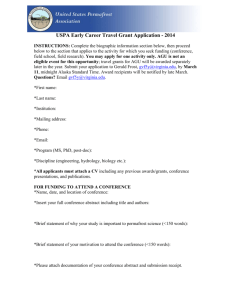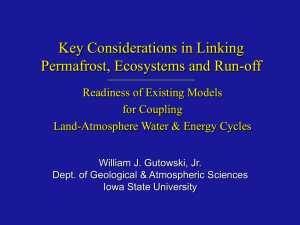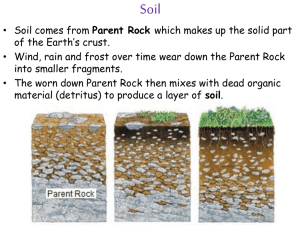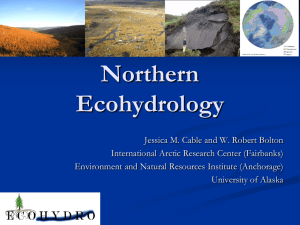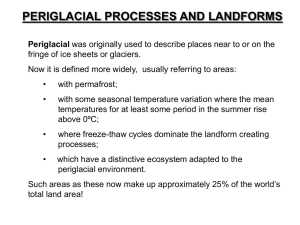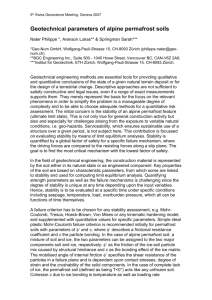PHYSICAL CONTROLS ON ANTARCTIC DRY VALLEYS PERMAFROST GEOMORPHOL-
advertisement
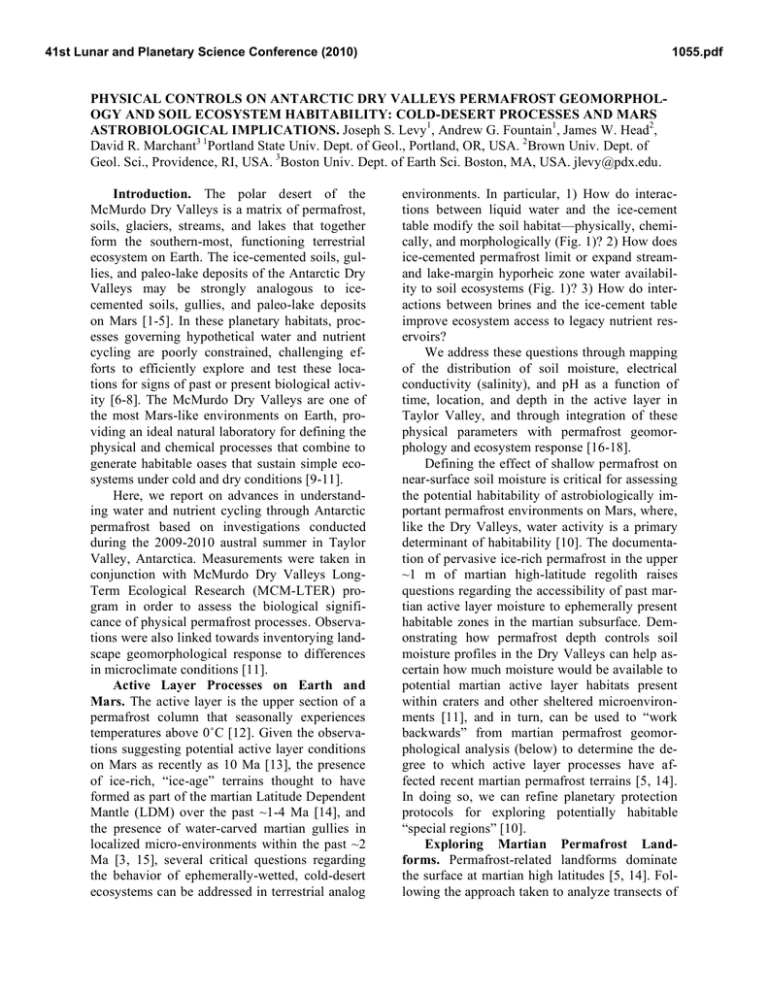
41st Lunar and Planetary Science Conference (2010) 1055.pdf PHYSICAL CONTROLS ON ANTARCTIC DRY VALLEYS PERMAFROST GEOMORPHOLOGY AND SOIL ECOSYSTEM HABITABILITY: COLD-DESERT PROCESSES AND MARS ASTROBIOLOGICAL IMPLICATIONS. Joseph S. Levy1, Andrew G. Fountain1, James W. Head2, David R. Marchant3 1Portland State Univ. Dept. of Geol., Portland, OR, USA. 2 Brown Univ. Dept. of Geol. Sci., Providence, RI, USA. 3Boston Univ. Dept. of Earth Sci. Boston, MA, USA. jlevy@pdx.edu. Introduction. The polar desert of the McMurdo Dry Valleys is a matrix of permafrost, soils, glaciers, streams, and lakes that together form the southern-most, functioning terrestrial ecosystem on Earth. The ice-cemented soils, gullies, and paleo-lake deposits of the Antarctic Dry Valleys may be strongly analogous to icecemented soils, gullies, and paleo-lake deposits on Mars [1-5]. In these planetary habitats, processes governing hypothetical water and nutrient cycling are poorly constrained, challenging efforts to efficiently explore and test these locations for signs of past or present biological activity [6-8]. The McMurdo Dry Valleys are one of the most Mars-like environments on Earth, providing an ideal natural laboratory for defining the physical and chemical processes that combine to generate habitable oases that sustain simple ecosystems under cold and dry conditions [9-11]. Here, we report on advances in understanding water and nutrient cycling through Antarctic permafrost based on investigations conducted during the 2009-2010 austral summer in Taylor Valley, Antarctica. Measurements were taken in conjunction with McMurdo Dry Valleys LongTerm Ecological Research (MCM-LTER) program in order to assess the biological significance of physical permafrost processes. Observations were also linked towards inventorying landscape geomorphological response to differences in microclimate conditions [11]. Active Layer Processes on Earth and Mars. The active layer is the upper section of a permafrost column that seasonally experiences temperatures above 0˚C [12]. Given the observations suggesting potential active layer conditions on Mars as recently as 10 Ma [13], the presence of ice-rich, “ice-age” terrains thought to have formed as part of the martian Latitude Dependent Mantle (LDM) over the past ~1-4 Ma [14], and the presence of water-carved martian gullies in localized micro-environments within the past ~2 Ma [3, 15], several critical questions regarding the behavior of ephemerally-wetted, cold-desert ecosystems can be addressed in terrestrial analog environments. In particular, 1) How do interactions between liquid water and the ice-cement table modify the soil habitat—physically, chemically, and morphologically (Fig. 1)? 2) How does ice-cemented permafrost limit or expand streamand lake-margin hyporheic zone water availability to soil ecosystems (Fig. 1)? 3) How do interactions between brines and the ice-cement table improve ecosystem access to legacy nutrient reservoirs? We address these questions through mapping of the distribution of soil moisture, electrical conductivity (salinity), and pH as a function of time, location, and depth in the active layer in Taylor Valley, and through integration of these physical parameters with permafrost geomorphology and ecosystem response [16-18]. Defining the effect of shallow permafrost on near-surface soil moisture is critical for assessing the potential habitability of astrobiologically important permafrost environments on Mars, where, like the Dry Valleys, water activity is a primary determinant of habitability [10]. The documentation of pervasive ice-rich permafrost in the upper ~1 m of martian high-latitude regolith raises questions regarding the accessibility of past martian active layer moisture to ephemerally present habitable zones in the martian subsurface. Demonstrating how permafrost depth controls soil moisture profiles in the Dry Valleys can help ascertain how much moisture would be available to potential martian active layer habitats present within craters and other sheltered microenvironments [11], and in turn, can be used to “work backwards” from martian permafrost geomorphological analysis (below) to determine the degree to which active layer processes have affected recent martian permafrost terrains [5, 14]. In doing so, we can refine planetary protection protocols for exploring potentially habitable “special regions” [10]. Exploring Martian Permafrost Landforms. Permafrost-related landforms dominate the surface at martian high latitudes [5, 14]. Following the approach taken to analyze transects of 41st Lunar and Planetary Science Conference (2010) soil properties developed for characterizing Antarctic permafrost habitats and landforms (above), we present a geo-traverse of martian permafrost landforms, anchored at the Phoenix landing site and extending north to the edge of the north-polar cap, and south to the edge of the Tharsis rise. By documenting martian permafrost landforms, including high- and low-centered thermal contraction crack polygons [11], sorted or otherwise arranged boulders (including “boulder halos”) [19], and both massive- and pore-filling ground ice, we will be able to evaluate the soil and climate conditions prevailing during the formation and modification of these cold-desert landforms. Acknowledgements. This work is supported by the Antarctic Organisms and Ecosystems Program in the Antarctic Sciences Division of the NSF, Award #ANT-0851965. References. [1] Squyres, S.W. (1989) Icarus, 79, 229-288. [2] Malin M.C. and Edgett, K.S. (2001) JGR, 106, 23429-23540. [3] Dickson et al. (2007) Icarus, 188, 315-323. [4] Head, J.W. et al. (2008) PNAS, 105, 13258-13263. [5] Levy, J.S. (2009) Icarus, 201, 113-126. [6] Hecht, M.H. (2002) Icarus, 156, 373-386. [7] Heldmann, J.L. (2007) Icarus, 188, 324-344. [8] Williams, K.E. 1055.pdf (2008) Icarus, 196, 565-577. [9] Baker, V.R. (2001) Nature, 412, 228-236. [10] SR-SAG (2006) Astrobio., 6, 677-732. [11] Marchant, D.R. & Head, J.W. (2007) Icarus, 192, 187-222. [12] Washburn, A.L. (1973) Periglacial Processes and Environments, Edw. Arnold., 320 pp. [13] Kreslavsky, M.A. et al. (2008) 56, 289-302.[14] Head, J.W. et al. (2003) Nature, 426, 797-802. [15] Schon, S.C. (2009) Geology, 37, 207-210. [16] Fountain, A.G. et al. (1999) BioSci., 49, 961-971. [17] Barrett, J.E. et al. (2004) Ecology, 85, 3105-3118. [18] McKnight, D.M. et al. (1999) BioSci., 49, 985-995. [19] Levy, J.S. et al. (2008) LPSC39, Abstr. 1172. Figure 1. The Onyx River, Wright Valley, Antarctica. At image top, changes in surface microtopography caused by thermal contraction crack polygons strongly influence the distribution of soil moisture (indicated by soil darkening). In contrast, at image bottom, fluvial channel structure more strongly influences the spatial distribution of soil moisture and biological productivity.
